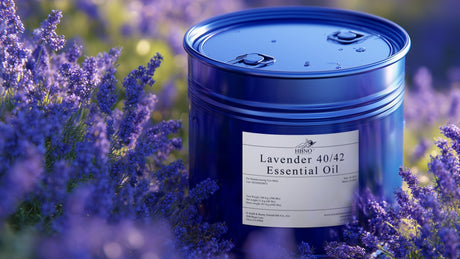Peppermint oil is a staple in aromatherapy, personal care, and household use, celebrated for its cool, crisp scent and refreshing qualities. Among the different types, two stand out: Japanese peppermint essential oil and regular peppermint oil, also known simply as peppermint essential oil.
Although both share a similar minty aroma, they differ significantly in origin, composition, and sensory experience. In this guide, we'll explore Japanese Peppermint vs Regular Peppermint to help you better understand which is best suited for your needs.
Japanese Peppermint vs Regular Peppermint: Key Differences
Let's break down the main distinctions between Japanese peppermint essential oil and peppermint essential oil:
1. Botanical Source
- Japanese Peppermint Oil: Derived from Mentha arvensis
- Regular Peppermint Oil: Extracted from Mentha piperita
Though both belong to the mint family, the plants are different species with distinct chemical profiles.
2. Menthol Content
- Japanese Peppermint Oil: Contains up to 95% menthol
- Regular Peppermint Oil: Contains 40-60% menthol
This single difference dramatically changes their aroma and cooling properties. The menthol level in Japanese peppermint creates a sharper and more intense sensation, whereas regular peppermint offers a balanced and approachable mint fragrance.
3. Aroma and Strength
- Japanese Peppermint: Piercing, cool, and slightly medicinal
- Regular Peppermint: Sweet, minty, and more rounded
If you're looking for a bold mint scent that cuts through other aromas, Japanese peppermint might be the better choice. For those who prefer a classic minty freshness, regular peppermint oil is more universally pleasing.
4. Use in Formulations
- Japanese Peppermint Oil is often preferred in formulations that require a stronger mint impact-like aftershaves, foot sprays, and cooling lip balms.
- Regular Peppermint Oil is better suited for perfumes, creams, and diffusers where a milder scent is more appropriate.
Popular Applications of Peppermint Japanese Essential Oil
Due to its high menthol content, Japanese peppermint oil is favored for its sensory intensity. Common uses include peppermint Japanese essential oil in shampoo, where it provides a cooling sensation. Here are more uses:
- Room Fresheners: Offers a burst of freshness to eliminate odors.
- Foot and Body Sprays: Creates a cooling effect on contact.
- Cosmetics: Adds a clarifying, minty fragrance to soaps and body lotions.
- Natural Cleaning Products: Imparts a crisp scent and helps neutralize other strong odors.
Its penetrating aroma makes it a strong contender for DIY blends, particularly for summer-themed or energizing applications.

Uses of Regular Peppermint Essential Oil
Peppermint essential oil (Mentha piperita) is more common in multipurpose blends and wellness products due to its versatile scent and gentler feel. It's often included in:
- Candle and Diffuser Blends: Adds freshness and focus.
- Personal Care: Ideal in shampoos, face masks, and creams for its gentle minty aroma.
- Aromatic Sprays: Works well in holiday-themed or spa-style fragrances.
- Household Cleaners: Lends a light, refreshing finish without overwhelming other notes.
This version of peppermint oil is considered an excellent "all-rounder" in the essential oil world.
Japanese Peppermint vs Regular Peppermint: Which One Should You Choose?
Choosing between Japanese peppermint oil vs regular peppermint oil comes down to your intended use and personal scent preferences.
|
Criteria |
Japanese Peppermint Oil |
Regular Peppermint Oil |
|
Menthol Strength |
Very High (up to 95%) |
Moderate (40-60%) |
|
Aroma |
Sharp, bold, and cooling |
Sweet, fresh, and minty |
|
Best For |
Intense freshness, cooling blends |
Balanced personal care, aroma use |
|
Skin Sensitivity |
Higher chance of irritation |
Gentler on skin (with dilution) |
|
Common Name |
Peppermint Japanese Essential Oil |
Peppermint Essential Oil |
If you want a striking mint experience, Japanese peppermint essential oil is your go-to. For general-purpose applications and subtle fragrance layers, regular peppermint oil is more adaptable.
Label Clarity: Don't Be Confused by the Names
Product names can sometimes be misleading. When purchasing, look for the botanical name:
- Mentha arvensis = Japanese Peppermint Oil
- Mentha piperita = Regular Peppermint Oil
This distinction ensures you're buying the correct oil for your intended use. Some sellers may label both simply as "peppermint oil," so it's worth verifying the species on the packaging or product description.
Tips for Safe and Effective Use
Regardless of the type, all peppermint oils should be used with care. Here are a few helpful guidelines:
- Always dilute with a carrier oil before applying to the skin.
- Perform a patch test to check for sensitivity.
- Avoid contact with eyes and mucous membranes.
- Keep out of reach of children and pets.
- Store in a cool, dark place to preserve freshness.
These precautions apply equally to peppermint Japanese essential oil and peppermint essential oil.
Final Thoughts
Both Japanese peppermint oil and regular peppermint oil offer refreshing, invigorating qualities, but they're not interchangeable. Knowing the difference between Japanese peppermint vs regular peppermint helps you select the right oil for your personal or commercial needs. If you're after a bold, mint-forward aroma with powerful sensory properties, go for Japanese peppermint essential oil.
For a more traditional, mild, and balanced mint scent, peppermint essential oil from Mentha piperita is ideal. HBNO bulk offers both varieties in bulk, ensuring you get premium quality oils tailored to your specific formulation needs.




